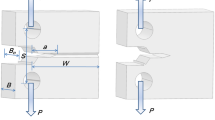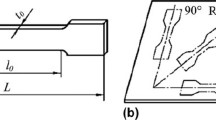Abstract
Using finite element analysis, metallographic observations and statistical analysis, the stress field ahead of stationary and growing cracks and the ductile-brittle transition mechanism in compact tension (CT) specimens have been evaluated. Compared to a stationary crack, a growing crack elevates the opening stress on the remaining ligament and this may be partially attributed to the re-sharpening of the crack tip after ductile growth. The area of material covered by the high opening stress of the same magnitude also increases with ductile crack growth. In this study, no significant difference for measured cleavage stress can be found for the specimens fractured with and without ductile crack growth. There is a large scatter for the distance between the cleavage initiation site and the stationary or growing crack tip. Cleavage fracture after some amount of ductile crack growth is attributed to the increase of both the opening stress and the area of material under high opening stresses. Finally, the lower bound toughness is predicted using a small data set statistical model in connection with constraint correction. The predicted values give the same trend as the lower bound of the experimental measurements from the lower-shelf to the temperature at which ductile crack growth occurs.
Similar content being viewed by others
References
ABAQUS (1996). User's manual, Version 5.4. Hibbitt, Karlsson and Sorensen, Providence, R.I.
Anderson, T.L. and Dodds, Jr., R.H. (1991). Specimen size requirements for fracture toughness testing in the transition region. Journal of Testing and Evolution 19, 123–134.
Anderson, T.L. (1989). A combined statistical and constraint model for the ductile-brittle transition region. In Nonlinear Fracture Mechanics: Volume II-Elastic-Plastic fracture, ASTM STP 995, Landes et al. (eds.), 563–583.
Beremin, F.M. (1983). A local criterion for cleavage fracture of a nuclear pressure vessel steel. Metallurgical Transactions 14A, 2277–2287.
Bowen, P., Druce, S.G. and Knott, J.F. (1986). Effects of microstructure on cleavage fracture in pressure vessel steel. Acta Metallurgica 34, 1121–1131.
Chen, J.H., Yan, C. and Sun, J. (1994). Further study on the mechanism of cleavage fracture at low temperature. Acta Metallurgical and Materials 42, 251–261.
Chen, J.H., Zhu, L. and Ma, H. (1990). On the scattering of the local fracture stress σf. Acta Metallurgical and Materials 38, 2527–2535.
Curry, D.A. and Knott, J.F. (1976). The relationship between fracture toughness and microstructure in the cleavage fracture of mild steel. Metal Science 10, 1–6.
Curry, D.A. and Knott, J.F. (1979). Effect of microstructure on cleavage fracture toughness of quenched and tempered steels. Metal Science 13, 341–345.
Dodds, Jr., R.H., Anderson, T.L. and Kirk, M.T. (1991). A framework to correlate a/W ratio effects on elastic-plastic fracture toughness (J c ). International Journal of Fracture 48, 1–22.
Hutchinson, J.W. (1968). Singular behaviour at the end of a tensile crack in a hardening material. Journal of Mechanics and Physics of Solids 16, 13–31.
Landes, J.D., Heerens, J., Schwalbe, K.H. and Petrovski, B. (1993). Fatigue and Fracture of Engineering Materials and Structure 16, 1135–1146.
Lewandowski, J.J. and Thompson, A.W. (1987). Micromechanics of cleavage fracture in fully pearlitic microstructures. Acta Metallurgica 35, 1453–1462.
Lin, T., Evans, A.G. and Ritchie, R.O. (1986). A statistical model of brittle fracture by transgranular cleavage. Acta Metallurgica 34, 2205–2216.
McMeeking, R.M. (1977). Finite deformation analysis of crack-tip opening in elastic plastic materials and implications for fracture. Journal of Mechanics and Physics of Solids 25, 357–381.
O'Dowd, N.P. and Shih, C.F. (1991). Family of crack-tip fields characterized by a triaxiality parameter-I structure of fields. Journal of Mechanics and Physics of Solids 39, 989–1015.
O'Dowd, N.P. and Shih, C.F. (1992). Family of crack-tip fields characterized by a triaxiality parameter-II fracture applications. Journal of Mechanics and Physics of Solids 40, 939–963.
O'Dowd, N.P. and Shih, C.F. (1994). Fracture Mechanics: Twenty-Fourth Volume, ASTM STP 1207, Philadelphia 21–47.
O'Dowd, N.P. and Shih, C.F. (1995). Constraint Effect in Fracture Theory and Application: Second Volume, ASTM STP 1244, Philadelphia, 134–159.
O'Dowd, N.P., Shih, C.F. and Dodds, Jr., R.H. (1994). The role of geometry and crack growth on constraint and implications for ductile/brittle fracture. Constraint Effect in Fracture: Theory and Application, ASTM STP 1244, M. Kirk and A. Bakker (eds.), 134–159.
Ritchie, R.O., Knott, J.F. and Rice, J.R. (1973). On the relationship between critical tensile stress and fracture toughness in mild steel. Journal of Mechanics and Physics of Solids 21, 395–410.
Ruggieri, C. and Dodds, Jr., R.H. (1996). A transferability model for brittle fracture including constraint and ductile tearing effects: a probabilistic approach. International Journal of Fracture 79, 309–340.
Rice, J.R. and Rosengren, G.F. (1968). Plane strain deformation near a crack tip in a power-law hardening material. Journal of Mechanics and Physics of Solids 16, 1–12.
Rosenfield, A.R. and Shetty, D.K. (1983). Cleavage fracture of steel in the upper ductile brittle transition region. Engineering Fracture Mechanics 17, 461–470.
Rice, J.R. and Sorensen, E.P. (1978). Continuing crack-tip deformation and fracture for plane-strain crack growth in elastic-plastic solids. Journal of Mechanics and Physics of Solids 26, 163–186.
Rice, J.R., Drugan, W.J. and Sham, T.-L. (1980). Elastic-plastic analysis of growing cracks. Fracture Mechanics: Twelfth Conference, ASTM STP 700, Philadelphia, 189–221.
Shehu, S. and Nilsson, F. (1997). Two parameter description of crack growth initiation including thickness effects through probabilistic modelling. Fatigue and Fracture of Engineering Materials and Structures 20, 179–199.
Stienstra, D., Anderson, T.L. and Ringer, L.J. (1990). Statistical references on cleavage fracture toughness data. Journal of Engineering Materials and Technology 112, 31–37.
Strnadel, B., Mazancova, E., Havel, S. and Mazanec, S. (1986). Prediction of fracture toughness for a pressure vessel steel with mixed bainite-ferritic microstructure. International Journal of Pressure Vessels and Piping 23, 47–60.
Varias, A.G. and Shih, C.F. (1993). Quasi-static crack advance under a range of constraint: steady-state fields based a characteristic length. Journal of Mechanics and Physics of Solids 41, 835–861.
Wallin, K. (1989). The effect of ligament size on cleavage fracture toughness. Engineering Fracture Mechanics 32, 449–457.
Wallin, K. (1989). The effect of ductile tearing on cleavage fracture probability in fracture toughness testing. Engineering Fracture Mechanics 32, 523–531.
Wallin, K. (1993). Statistical aspects of constraint with emphasis on testing and analysis of laboratory specimens in the transition region. Constraint Effect in Fracture: First Volume, ASTM STP 1171, Philadelphia, 264–288.
Wu, S.X., Mai, Y.W. and Cotterell, B. (1995). Prediction of the initiation of ductile fracture. Journal of Mechanics and Physics of Solids 43, 793–810.
Xia, L. and Shih, C.F. (1996). Ductile crack growth-III. Transition to cleavage fracture incorporating statistics. Journal of Mechanics and Physics of Solids 44, 603–639.
Xin, X.J. and Goldthorpe, M.R. (1993). Finite element analysis of stable crack growth in three sizes of compact specimens of A508 steel. Fatigue and Fracture of Engineering Materials and Structures 16, 1309–1327.
Yan, C., Wu, S.X. and Mai, Y.W. (1997). Application of J-Q theory to the local approach statistical model of cleavage fracture. Fatigue and Fracture Mechanics: 28th Volume, ASTM STP 1321, Underwood et al. (eds.), 296–308.
Yan, C., Chen, J.H., Sun, J. and Wang, Z. (1993). Critical assessment of the local cleavage stress σf in notch specimens of C-Mn steel. Metallurgical Transactions 24A, 1381–1389.
Zerbst, U., Heerns, J. and Schwalbe, K.H. (1993). Estimation of lower-bound fracture resistance of pressure vessel steel in the transition region. Fatigue and Fracture of Engineering Materials and Structure 16, 1147–1160.
Author information
Authors and Affiliations
Rights and permissions
About this article
Cite this article
Yan, C., Mai, YW. & Wu, SX. Finite element analysis and experimental evaluation of ductile-brittle transition in compact tension specimen. International Journal of Fracture 87, 345–362 (1997). https://doi.org/10.1023/A:1007468628589
Issue Date:
DOI: https://doi.org/10.1023/A:1007468628589




